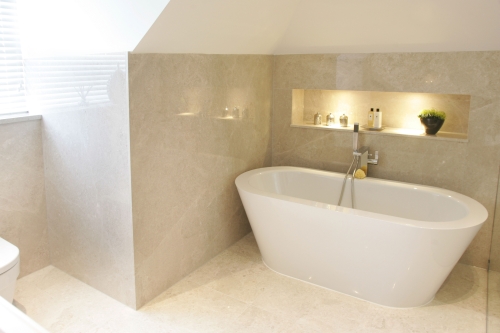Bath
Contents |
[edit] Introduction
A bath (sometimes referred to as a bathtub or tub) is a large container for water that can be used for immersing or washing a person's body (or sometimes other objects). NB A bath can also be a type of appliance that is used to collect and remove water (by way of an overflow or waste drain) once it has been used.
[edit] History
Evidence of the ritual act of bathing dates back to ancient times. This act typically took place in communal bath houses.
Early versions of personal baths supplied by water pipes (rather than buckets of water that have been carried) have been found in Ancient Greece. The baths were made from clay or ceramic and supplied by copper pipes.
The Ancient Romans developed a form of heating water for baths which used hot materials such as rocks. The heated water was then poured into the bath.
Advances in the manufacture of the bath took place in the 18th century. This came with the adoption of cast iron, tin and copper as a suitable material for stand alone baths. These devices were primarily used by the aristocracy and became more elaborately designed and decorated.
They were also manufactured from porcelain (a ceramic material made from clay that might be described as 'vitreous china' when coated with enamel). This might be referred to as ceramic, porcelain or china sanitaryware and is often white, with the incorporation of porcelain enamel coatings.
In the 20th century, smaller spaces and increased demand drove the introduction of more utilitarian baths. These baths were built in rather than stand alone units that were eventually made from lighter materials that were less expensive to produce and easier to maintain.
[edit] Types of baths
Modern baths are made from a wide range of materials, including coated metals, cast iron, steel, acrylics, fibreglass and so on. They can be produced in a variety of shapes and colours, although they are typically rectilinear and long enough to accommodate a person who is in a reclined position.
There are several different types of installed or stand alone baths. These can include:
- Accessible (including walk-in or gated versions).
- Clawfoot and pedestal.
- Corner baths.
- Drop-in baths.
- Freestanding.
- Recessed or alcove.
- Soft baths.
- Steel baths.
- Shower baths.
- Sunken bath.
- Whirlpool baths or spa tubs.
[edit] Building regulations
The Building Regulations Approved Document G: Sanitation, hot water safety and water efficiency suggests that a bath is a type of sanitary appliance or sanitary ware that is further described as part of a bathroom (‘…a room containing a bath or shower and, in addition, can also include sanitary accommodation.')
Approved Document G prescribes maximum water consumption limits for baths and a maximum water temperature.
Approved Document M – Access to and Use of Buildings, includes minimum requirements for space available around a bath.
Additional requirements for drainage are set out in Approved Document H: drainage and waste disposal.
[edit] Related articles on Designing Buildings
Featured articles and news
Latest Build UK Building Safety Regime explainer published
Key elements in one short, now updated document.
UKGBC launch the UK Climate Resilience Roadmap
First guidance of its kind on direct climate impacts for the built environment and how it can adapt.
CLC Health, Safety and Wellbeing Strategy 2025
Launched by the Minister for Industry to look at fatalities on site, improving mental health and other issues.
One of the most impressive Victorian architects. Book review.
Common Assessment Standard now with building safety
New CAS update now includes mandatory building safety questions.
RTPI leader to become new CIOB Chief Executive Officer
Dr Victoria Hills MRTPI, FICE to take over after Caroline Gumble’s departure.
Social and affordable housing, a long term plan for delivery
The “Delivering a Decade of Renewal for Social and Affordable Housing” strategy sets out future path.
A change to adoptive architecture
Effects of global weather warming on architectural detailing, material choice and human interaction.
The proposed publicly owned and backed subsidiary of Homes England, to facilitate new homes.
How big is the problem and what can we do to mitigate the effects?
Overheating guidance and tools for building designers
A number of cool guides to help with the heat.
The UK's Modern Industrial Strategy: A 10 year plan
Previous consultation criticism, current key elements and general support with some persisting reservations.
Building Safety Regulator reforms
New roles, new staff and a new fast track service pave the way for a single construction regulator.
Architectural Technologist CPDs and Communications
CIAT CPD… and how you can do it!
Cooling centres and cool spaces
Managing extreme heat in cities by directing the public to places for heat stress relief and water sources.
Winter gardens: A brief history and warm variations
Extending the season with glass in different forms and terms.
Restoring Great Yarmouth's Winter Gardens
Transforming one of the least sustainable constructions imaginable.























